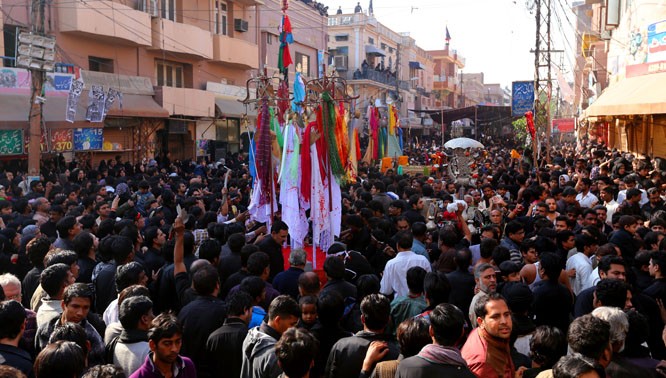
Acceptance of grief and sadness as a necessary element of all lives guards against individual hopelessness and despair

As a child raised in a Sunni household, I had an enduring fascination with newspaper pictures that appeared a day after Ashura, of bare-chested men standing in a circle as they flogged themselves with open palms, nunchuks and knives -- rivulets of blood trickling down their backs.
It was a world far removed from the Wahabi stoicism that some of my born-again Sunni relatives prided themselves on: three days of mourning for the deceased and no more. Wailing, sobbing, chest-beating and other loud expressions of grief were seen as the province of the rural poor, not of educated city dwellers: Western sobriety in surprising harmony with Wahabi stoicism.
The Shias by contrast seemed passionate and unafraid to express their pain, even indulgent of it. If anything, they had forged a community through this pain that had traversed more than a thousand years and had given rise to extraordinary oratory, poetry and narrative.
The shaam-e-ghareebaan that PTV duly telecast every Ashura night was a spectacle of sorrow led by the fiery Allama Talib Johri who in the course of an hour would bring perfectly well-adjusted grown men to sob and keen with abandon. In fact, it was a mehfil that required you to weep, thus, an aberration in a world that expects the answers to all its how are yous to be very well thank yous.
It offered an alternate universe that understood the centrality of suffering to the human experience and lifted the taboo from its public expression; grasping the value of learning and relearning that we aren’t alone in our misery and vexation, and even if we are misunderstood, abandoned and starved, that is the inevitable lot of those who make principled stands for justice.
Oddly, the world’s major religions, all born in pre-industrial times, have the greatest psychological insight into the negative emotions of human beings, giving them the space to admit to and purge themselves of them. They recognise that without confession there is no moving on, a fact that modern science caught on to much later, producing therapists’ couches that allow people to concede the existence of twisted fantasies, gut-wrenching conflicts, past misdemeanours and childhood traumas.
But such is the fear of negative emotion in the Western world that it has been forced into dark corners where it can safely be allowed to make an appearance under the tutelage of one who is charging you $200 per hour to express your anguish.
It is rare these days for people to come together socially without a happy occasion to necessitate it. This gathering of people around food, drink, dance and music generates the inevitable sense that to be with others is to come together in joy. To quote the pedestrian: laugh and the world laughs with you, weep and you weep alone.
This idea is the underlying impulse that has given rise to the cult of ‘positive thinking,’ a notion that venerates happiness as an ultimate goal to be arrived at, permanent and unchangeable. Once you have cracked the code to being ‘positive’, i.e, taken a giant hammer to all the feelings that threaten to derail the single-minded pursuit of endless happiness: anxiety, fear, jealousy and hate, you will have arrived at the holy grail of mental peace.
This line of thought has resulted in far more miserable people than would have been the case if the book publishing industry had produced an equal number of texts on the importance of healthy doses of ‘negativity,’ or the need not to wish our human frailties away.
In a capitalist world that has witnessed leaps and bounds in scientific advancement in the last couple of centuries, a sense that humans can achieve anything if they put their mind to it has taken firm root in the psyches of individuals, particularly those belonging to prosperous first world countries where ‘having it all’ seems like a tangible possibility; and anyone failing to live up to this ideal a failure.
Read also: Perils of negativity
But the east, especially as witnessed from its poetic output seems to provide far greater room for frustrated emotion, self-doubt and even romanticised suicidal ideation. The Urdu poetical canon wallows in unabashed misery from Mir to Zauq, Ghalib to Zaidi without descending into maudlin sentimentality:
Qaid-e-hayaat o band-e-gham asl mayn dono aek hayn
Maut se pehlay aadmi gham se nijaat paae kyoon
(Ghalib)
Indian films dating back to a less commercial era were also flagrant tearjerkers, unselfconsciously revelling in misery and singing paeans to it.
Raahi manwa dukh ki chinta kyoon sataati hae, dukh tau apna saathi hae
Sukh tau hae chaaoon dhalti aati hae jaati hae, dukh tau apna saathi hae
This acceptance of grief and sadness as a necessary element of all lives guards against individual hopelessness and despair. The Wailing Wall in Jerusalem where for five centuries Jews have gathered to write down their sorrows on small pieces of paper and inserted them in crevices among the stones is an example of this solidarity of sorrow. Sometimes that can be enough.